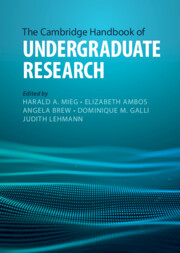Book contents
- The Cambridge Handbook of Undergraduate Research
- The Cambridge Handbook of Undergraduate Research
- Copyright page
- Contents
- Figures
- Tables
- Contributors
- Foreword
- Foreword
- 1 Introduction
- Part I Theory and Research on Undergraduate Research
- Part II Implementation, Approaches, Methods
- 7 Introduction
- Part II.1 Implementation Models in Undergraduate Research
- 8 The Zurich Framework
- 9 Four-Component Instructional Design Model, Maastricht
- 10 Connected Curriculum, UCL
- 11 Humboldt Reloaded, Hohenheim
- 12 The US Model at IUPUI
- Part II.2 Key Measures for the Implementation of Undergraduate Research
- Part III Disciplines
- Part IV International Perspective
- Part V Avenues for Developing Undergraduate Research
- Index
- References
12 - The US Model at IUPUI
from Part II.1 - Implementation Models in Undergraduate Research
Published online by Cambridge University Press: 11 August 2022
- The Cambridge Handbook of Undergraduate Research
- The Cambridge Handbook of Undergraduate Research
- Copyright page
- Contents
- Figures
- Tables
- Contributors
- Foreword
- Foreword
- 1 Introduction
- Part I Theory and Research on Undergraduate Research
- Part II Implementation, Approaches, Methods
- 7 Introduction
- Part II.1 Implementation Models in Undergraduate Research
- 8 The Zurich Framework
- 9 Four-Component Instructional Design Model, Maastricht
- 10 Connected Curriculum, UCL
- 11 Humboldt Reloaded, Hohenheim
- 12 The US Model at IUPUI
- Part II.2 Key Measures for the Implementation of Undergraduate Research
- Part III Disciplines
- Part IV International Perspective
- Part V Avenues for Developing Undergraduate Research
- Index
- References
Summary
Indiana University Purdue University–Indianapolis (IUPUI) is an urban public research university. Undergraduate research has been a cornerstone of the campus culture for more than twenty years. Currently, about 15% of undergraduate students engage in credit-bearing, paid, or volunteer research experiences. The campus-wide Center for Research and Learning (CRL) offers a comprehensive set of course-independent programs aimed at promoting innovative, inquiry-based learning across all undergraduate majors and populations during the academic year and summer recess. These programs support both one-on-one mentored research as well as opportunities to participate in team-based multidisciplinary research experiences that are documented in the digital Applied and Experiential Learning Record. Various research programs focus on engaging underrepresented minority, disadvantaged, and underserved students. Writing assignments and student and mentor surveys have confirmed that students engaged in undergraduate research acquire both research-specific and transferable skills.
- Type
- Chapter
- Information
- The Cambridge Handbook of Undergraduate Research , pp. 121 - 130Publisher: Cambridge University PressPrint publication year: 2022



